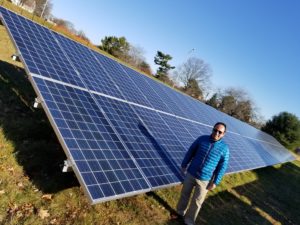Solar Energy Market Potential

Renewable energy assets managed on a distributed ledger via smart contracts promotes a robust, scalable energy infrastructure.
Sun Fund brings the world to the solar energy market, and we bring the solar energy market to the world.
(Check out our white paper for our innovative Producer-to-Investor platform and offer: www.StartEngine.com/sun-fund-dc.)
The untapped solar energy market is not as large as the sun, but it has everything to do with the surface area of the Earth and its map of existing infrastructure.
There is an incredible synergy in the concept of a six-fold increase in solar energy market development for the United States and the world. On the one hand, that is exactly the multiple that IRENA put forth in a document saying that global warming from greenhouse gas emission could potentially be halted at a 2-degrees higher: a six-fold increase in the solar energy market. On the other hand, that is exactly how much under-developed potential there is to put solar panels on the low-to-medium income housing sector in the US, according to a new study published by NREL: a six-fold increase in the existing solar energy market.
There is an opportunity in the United States for a six-fold increase in solar energy market development using low-to-medium income housing as an installation base. That would amount to a 320 Gigawatts of a developed solar energy market. Those are houses that are 80% and lower of housing prices. If those homes are leased or rented, the assets are more likely to stay on-location because they transfer ownership less frequently. Since the incomes specified in the study are by definition lower than top-tier incomes, the lowered energy bill from the solar panels makes a bigger difference to those bill payers.
“The findings show that a substantial fraction of the national rooftop solar potential is located on LMI buildings and, for all incomes, a substantial fraction is located on multi-family and renter-occupied buildings. The research also demonstrates that reaching substantial LMI deployment penetration requires deployment on multi-family and renter-occupied buildings. Traditional deployment models have insufficiently enabled access to solar for these income groups and building types and, without additional innovation either in regulatory, market or policy arenas, a large fraction of the U.S. potential is unlikely to be met.” (www.nrel.gov/publications).
To reach IRENA’s goal of a six-fold increase in solar energy market installations worldwide, the world needs Sun Fund’s renewable energy market investment platform: The PIP. Sun Fund’s PIP is currently in development. The PIP makes it easier than ever for investors, producers, and consumers to have an easy-to-understand, transparent, blockchain, distributed ledger/trustless platform that gives all stakeholders the information they need about a project in order to participate.
“An opportunity exists to ramp up investment in low-carbon technologies and shift the global development paradigm from scarcity, inequality, and competition to one of shared prosperity – in our lifetimes,” said IRENA Director-General Adnan Z. Amin. “That is an opportunity we must rally behind by adopting strong policies, mobilizing capital and driving innovation across the energy system,” Amin said.
Obviously, to reach a goal of a six-fold increase in the solar energy market both within the United States and around the world, many stakeholders will have to participate, including governmental and non-governmental organizations, and stakeholders in the energy sector.
We save the planet by making renewable energy investment available to the world. Check us out at www.StartEngine.com/sun-fund-dc.